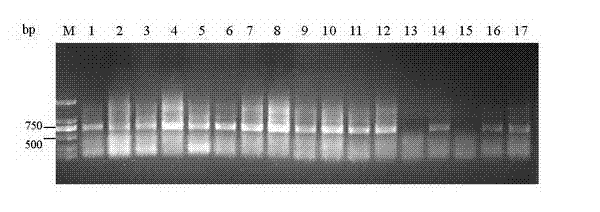Murine human colorectal cancer-resistant Fab phage antibody library and construction method thereof
A technology for a phage antibody library and a construction method is applied in the field of construction of a mouse anti-human colorectal cancer Fab antibody library to achieve the effects of improved accuracy and sensitivity and a simple method
- Summary
- Abstract
- Description
- Claims
- Application Information
AI Technical Summary
Problems solved by technology
Method used
Image
Examples
Embodiment 1
[0032] Immunize BALB / C mice
[0033] 1. Mix 21 cases of drug-resistant colorectal cancer tissues in equal amounts and place them in a weighed centrifuge tube, then add an appropriate amount of sterile saline, homogenize, sterilize, and mix with Freund's incomplete adjuvant 1:1 evenly , To obtain colorectal cancer tissue homogenate for immunization;
[0034] 2. Take multi-point injection (0.2mL / 10g) of colorectal cancer tissue homogenate for immunization to immunize BALB / C mice, and immunize BALB / C mice again in the same way on 7 days and 14 days after the first immunization, and 7 days after the last immunization Take blood from the orbit, centrifuge, and save the supernatant for use;
[0035] 3. Enzyme-linked immunosorbent assay (ELISA) to determine antibody titer: ①Coat the wells of the ELISA plate with the above-mentioned colorectal cancer tissue homogenate (100μL / well), and incubate at 37°C for 2 hours; ②Discard the homogenate and use 3% BSA The ELISA plate is blocked by f...
Embodiment 2
[0037] Obtain mouse spleen cDNA library
[0038] 1. Extract total RNA from spleen of immunized mice
[0039] (1) The mouse was killed, the spleen was taken out and placed in normal saline. The mouse spleen was cut into small pieces with scissors and washed with normal saline, then placed in liquid nitrogen and fully frozen. The frozen tissue pieces were put into pre-cooled Store in a centrifuge tube at -80°C and take it out when used;
[0040] (2) After fully pre-cooling the mortar with liquid nitrogen, put 50-100mg of spleen tissue into the mortar, grind it into a powder, add 1mL Trizol and continue grinding until it becomes uniform and transparent;
[0041] (3) Transfer the grinding solution to a centrifuge tube, leave it at room temperature for 5 minutes, centrifuge at 4°C, 13500 rpm for 5 minutes, and transfer the supernatant to a new centrifuge tube;
[0042] (4) Add 200μL of chloroform, cover the centrifuge tube tightly, shake vigorously for 15 seconds by hand, until the solutio...
Embodiment 3
[0054] Design primers and amplify gene fragments
[0055] 1. Design mouse Fab antibody primers
[0056] (1) Design 17 heavy chain upstream primers and 5 heavy chain downstream primers, with 5′ end introduced in the heavy chain primers Xho Ⅰ Restriction site, 3′ end introduced Spe Ⅰ Restriction site, see Table 1; 20 light chain upstream primers and 2 light chain downstream primers are designed, and the 5′ end of the light chain primer is introduced Sac Ⅰ restriction site, 3′ end primer introduced Xba Ⅰ restriction site, see Table 2;
[0057] Primer number Primer sequence HS1 GCCCTCGAGCAGATCCAGCTACAACAGTC HS2 GCCCTCGAGCAGGTCCAGCTGAAGCAGTC HS3 GCCCTCGAGCAGGTCCAACTGCAGCAGC HS4 GCCCTCGAGCAGGTTCAACTGCAACAGTC HS5 GCCCTCGAGCAGATCCAGTTGGTACAGTC HS6 GCCCTCGAGCAGATTACTCAGAAAGAGTC HS7 GCCCTCGAGCAGGTGCAGCTGAAGGAGTC HS8 GCGCTCGAGGAGGTCCAGCTGCAGCAGTC HS9 GCGCTCGAGGAGGTCCAGCTGCAACAATC HS10 GCGCTCGAGGAGGTACAGCTTCAGGAGTC HS11 GCGCTCGAGGAGGTGAAGCTGGTGGAAAC HS12 GCGCTCGAGGAAGTGA...
PUM
 Login to View More
Login to View More Abstract
Description
Claims
Application Information
 Login to View More
Login to View More - Generate Ideas
- Intellectual Property
- Life Sciences
- Materials
- Tech Scout
- Unparalleled Data Quality
- Higher Quality Content
- 60% Fewer Hallucinations
Browse by: Latest US Patents, China's latest patents, Technical Efficacy Thesaurus, Application Domain, Technology Topic, Popular Technical Reports.
© 2025 PatSnap. All rights reserved.Legal|Privacy policy|Modern Slavery Act Transparency Statement|Sitemap|About US| Contact US: help@patsnap.com



